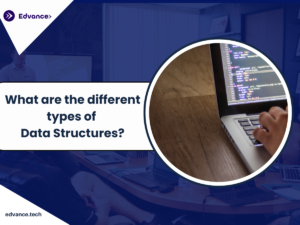Data structures play a pivotal role in computer science and software engineering. They provide efficient ways to organize, manage, and store data, making it easier to perform operations like searching, inserting, and deleting. Understanding data structures and algorithms is essential for anyone aiming to excel in the tech industry. In this blog, we will dive into the different types of data structures, their applications, and how they influence the efficiency of algorithms.
What Is a Data Structure?
A Data structure is a specialized format for organizing and storing data in a way that enables efficient access and modification. Data structures are fundamental to programming as they form the backbone of algorithms, enabling solutions to complex computational problems. They can be broadly categorized into primitive and non-primitive types.

Importance of Data Structures
- Efficiency: They help in optimizing memory usage and processing speed.
- Scalability: Proper data structures ensure systems handle large amounts of data.
- Reusability: These are versatile and can be adapted for various algorithms and programs.
Types of Data Structures
1. Linear Data Structures
Linear data arrange data in a sequential manner, making them simple to implement and understand. Examples include:
- Arrays: A collection of elements identified by an index or key. Arrays are used in scenarios where the size of the data is fixed.
- Applications: Storing data in tabular form, matrix operations.
- Linked Lists: Composed of nodes where each node contains data and a reference to the next node. They are dynamic in nature and allow for efficient insertion and deletion.
- Applications: Implementing queues and stacks, graph adjacency lists.
- Stacks: Operate on the principle of LIFO (Last In, First Out). Useful for tasks like reversing strings and parsing expressions.
- Applications: Function call stack, undo operations in text editors.
- Queues: Work on the FIFO (First In, First Out) principle. Used in scheduling and task management.
- Applications: CPU scheduling, print queue management.
2. Non-Linear Data Structures
Non-linear data structures organize data hierarchically, making them suitable for representing relationships between data elements. Examples include:
- Trees: A hierarchical structure consisting of nodes. The topmost node is the root, and other nodes are connected as children.
- Types: Binary Tree, Binary Search Tree, AVL Tree, B-Tree.
- Applications: Database indexing, expression parsing.
- Graphs: Represent relationships between pairs of objects. Consist of vertices (nodes) and edges (connections).
- Types: Directed, Undirected, Weighted.
- Applications: Social networks, navigation systems.
Advanced Data Structures
1. Hash Tables
Hash tables store data in key-value pairs, allowing for efficient searching and insertion. They use a hash function to compute an index into an array of buckets.
- Applications: Implementing dictionaries, caching.
2. Heaps
A specialized tree-based structure that satisfies the heap property (min-heap or max-heap).
- Applications: Priority queues, heap sort algorithm.
3. Trie
A tree-like structure used for storing strings. Each node represents a character of the string.
- Applications: Auto-complete features, spell checkers.
Algorithms and Data Structures: A Symbiotic Relationship
Algorithms work hand in hand with data . For instance, a sorting algorithm like QuickSort operates efficiently when combined with arrays. Similarly, search algorithms such as Breadth-First Search (BFS) and Depth-First Search (DFS) rely on graphs.
The choice of a structure can make or break the performance of an algorithm. Understanding which data structure to use for a specific problem is key to writing optimal code.
Why Learn Data Structures with Edvance?
Edvance is a cutting-edge edtech startup dedicated to empowering software engineers by enhancing their skills in data structures and algorithms (DSA) and system design—essential areas for excelling in the tech industry. Through a carefully designed curriculum and expert mentorship, Edvance bridges the gap between theoretical knowledge and practical application, ensuring engineers are job-ready for top-tier companies.
With a focus on career advancement, Edvance also provides placement assistance, guiding learners toward opportunities in leading organizations. Whether you are a beginner or an experienced developer looking to upskill, Edvance’s programs cater to all proficiency levels. Unlock your potential and become proficient in data structures and algorithms with Edvance.
Choosing the Right Data Structure
When deciding which data structure to use, consider the following:
- Nature of Operations: Will you perform more insertions, deletions, or lookups?
- Size of Data: The volume of data can determine memory requirements.
- Complexity: Different data structures have varying time complexities for operations.
Examples:
- Use arrays for simple, static datasets.
- Choose hash tables for quick lookups.
- Opt for trees or graphs for hierarchical or relational data.
Real-World Applications of Data Structures
1. Search Engines
Search engines like Google rely on data such as trees and graphs to store and retrieve information efficiently.
2. Social Media
Platforms like Facebook use graphs to represent connections between users, enabling features like friend suggestions.
3. Gaming
Gaming engines use it like heaps for collision detection and navigation systems.
Common Challenges in Learning Data Structures
- Choosing the Right Resource: The abundance of materials can be overwhelming.
- Application Over Theory: Many learners struggle to connect theoretical concepts with real-world applications.
- Understanding Complexity: Grasping time and space complexities can be daunting for beginners.
How Edvance Helps Overcome These Challenges
Edvance’s hands-on approach to teaching data structures ensures you not only understand the concepts but also apply them to solve real-world problems. The interactive curriculum, paired with expert guidance, demystifies complexities and builds confidence in tackling challenging coding interviews. Join Edvance and transform your understanding of today.
Conclusion
Mastering data structures is a vital step for any aspiring software engineer. From arrays and linked lists to advanced structures like graphs and tries, the right knowledge opens the door to creating efficient and scalable solutions. By learning these skills with Edvance, you gain the expertise and confidence to excel in a competitive tech landscape. Don’t just learn—advance with Edvance!



